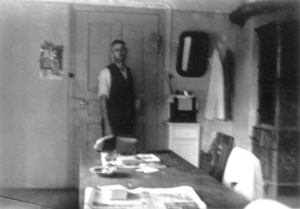 |
| Grafeneck Apartment for T4 Personnel |
On the site of a former medieval castle,
between 1556 and 1560
Grafeneck Castle was built on a hill near
Marbach.
During 1762 and 1772, Duke
Karl Eugen converted the castle to a
contemporary style. In
1929 a Samaritan foundation took over the
building in order to install a home for physically and mentally handicapped persons.
On
24 May 1939, a first visitation by members of
Aktion T4 took
place in order to find out if the building could be used for their
program, and on
14 October Grafeneck Castle was duly confiscated.
Between 10 and 15 manual labourers from nearby villages started to
convert the castle into a killing centre.
300 m away from the castle several barracks were built, fenced
in with a hoarding up to 4 m high. On the first floor of the
castle the following facilities were installed: accomodations and
offices for the doctors, a registry office, a police office, the
office for the comfort letters and others. On the second floor,
small living- and sleeping rooms for the personnel were installed.
The main building of the killing facility was a barrack (68 m
long and 7 m wide), which included several rooms. In one of
them 100 beds were placed, covered with straw-bags. Three big buses
for transportation of the victims and an ambulance car stood in a
wooden garage. Two mobile cremation ovens were located in another
wooden barrack. Because of the immense heat, generated by the
round-the-clock cremation, the roof of the barrack was removed and
after a short time the surrounding trees even blackened. The gas chamber,
resembling a shower bath, could hold 75 persons.
A former horse stable (round and 15 m in diameter) probably
served as storage room for the corpses. At the bottom of the hill,
at the access road, a high hoarding and a guardhouse were built.
Fences with barbed wire surrounded the whole castle whilst armed
guards with dogs patrolled these perimeters.
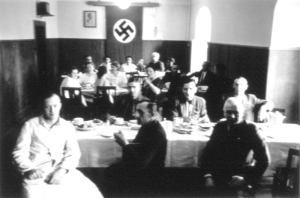 |
| Grafeneck Dining Hall #1 |
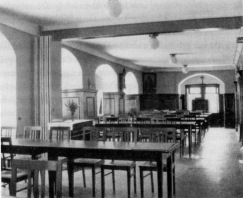 |
| Grafeneck Dining Hall #2 * |
In
mid-November 1939, SS men, typists and other personnel arrived
and were supplemented during
early January 1940 by approximately 25
nurses, some being male. In
mid-January the cremation ovens were
delivered. On
18 January 1940 the first transport of 25 handicapped
men arrived from
Eglfing-Haar near
Munich, managed by the Grafeneck chief
Dr
Horst Schumann. He joined T4 since
early October 1939, after a meeting with
Viktor Brack in
Hitler's
chancellery. In
early summer of 1940 he was ordered to the
Sonnenstein euthanasia centre. Successors in Grafeneck:
Dr
Ernst Baumhardt and finally Dr
Günther Hennecke.
Chief of administration became
Christian Wirth, a detective superintendent
and
SS-Obersturmführer. He supervised the first gassings. Later
he became inspector of all
Aktion Reinhard extermination camps.
One former nurse described a transport to the Grafeneck killing centre:
"
The evening before the transport, we received a list with the names of the
patients who were picked up. Early in the morning, the buses drove up, and
the windows were pained gray up to the top. The patients received a slip
of paper with number. Then they filed by one by one, and we wrote the
number on the bare back in ink. Because they thought that we were going to
transfer them to another institution, they were generally quite calm.
Indeed, they did not know what was gong to happen to them. Then they were
led into a bus, always seventy-five. A few weeks later the clothes were
sent back from Grafeneck."
Source: Bronwyn Rebekah McFarland-Icke, "Nurses in Nazi Germany",
Princeton University Press, Chichester, UK 1999, p, 219.
The killing continued until
13 December 1940. Then Grafeneck was no
longer part of the euthanasia programme because, according to the plan,
all handicapped persons from the Grafeneck operational area had been killed.
Some of the personnel went on holiday while some were ordered to the
Hadamar euthanasia centre. A few remained at the castle to cover up all
tracks of the actions that happened there.
10,824 victims were gassed and cremated at this facility.
Of the 80-100 persons who carried out the euthanasia programme in
Grafeneck, only eight were accused; all others were untraceable.
The trial was held at the Jury Court
Tübingen from 8 June
until 5 July 1949. At its conclusion three men were sentenced to
prison (from 18 months to 5 years).
A number of
Aktion Reinhard personnel served at Grafeneck,
these include
Rudolf Beckmann, Helmut Bootz, Paul Bredow, Max Bree, Kurt D., Hermann
Felfe,
Kurt Franz *,
Karl Frenzel, Hans Girtzig, Heinrich Gley,
Lorenz Hackenholt *,
Fritz Konrad, Fritz Kraschewski,
Willi Mentz *,
Hermann Michel, August Miete, Josef Oberhauser, Karl Schluch, Erich
Schulz, Hans-Heinz Schütt, Gottfried Schwarz, Heinrich
Unverhau, Christian Wirth and Ernst Zierke.
The
Grafeneck Memorial was opened in
1990.
* See the Franz Photo Story!
* See the Hackenholt Photo Story!
* See the Mentz Photo Story!
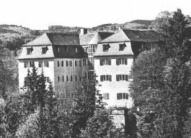
|
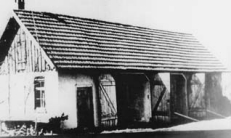
|
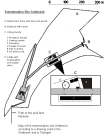
|
| Grafeneck |
Gas chamber |
Map |
Photo: Stöckle, Thomas.
Grafeneck 1940, Silberburg-Verlag, Tübingen,
2002
*
© ARC 2005
















